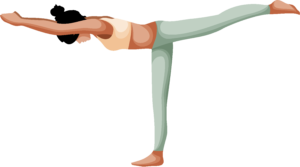Warrior III (Virabhadrasana III)
Pose Overview
| Common Name | Warrior III |
| Traditional Sanskrit Name | Virabhadrasana III |
| Sanskrit Name Pronunciation | veer-ah-bah-DRAHS-ah-nuh |
| Pose Difficulty | Intermediate |
| Drishti
Drishti is the gaze or visual focus point during yoga poses.
Learn more about Drishti |
Straight ahead or the nose |
Warrior III, or Virabhadrasana III, is a balancing pose that is named after a fierce warrior from Hindu mythology. This pose requires both strength and balance, making it a challenging one for many practitioners. However, with practice and patience, Warrior III can be a great way to strengthen the core, improve focus, and build stability in the legs and hips.
Benefits of Warrior III
Strengthens the core and legs Improves balance and focus Stretches the chest and hips Enhances sense of grounding
How to Enter Warrior III
Begin in Warrior II (Virabhadrasana II) with your right foot forward. Keep your right knee bent, and lift your left foot off the ground behind you. Bring your left leg parallel to the ground, and extend your arms out in front of you, parallel to the ground as well. Keep your gaze forward and engage your core to maintain balance in the pose.
How to Exit Warrior III
Lower your left foot back to the ground and come back to Warrior II. Repeat on the opposite side.
Common Warrior III Modifications & Variations
If balance is an issue, you can place your hands on a wall or block for support To deepen the stretch in the chest, you can bring your hands together in front of your heart in Anjali Mudra.
Common Mistakes with Warrior III
Locking the knee in the standing leg Allowing the hips to drop or sag Not engaging the core
Safety Guidance
Make sure to keep your knee bent in the standing leg Keep your gaze forward to maintain balance Avoid locking the knee in the standing leg

